Widely considered the most romantic (if most expensive) day of the year, Valentine’s day often brings with it pressure to spend more to prove one’s admiration. To help you avoid compromise on your Valentine’s day drinking, Wine Lister has put together a list of red Value pick MUST BUYs with WL scores above 95.
Click here to view all red Value pick MUST BUYs, or read more below.
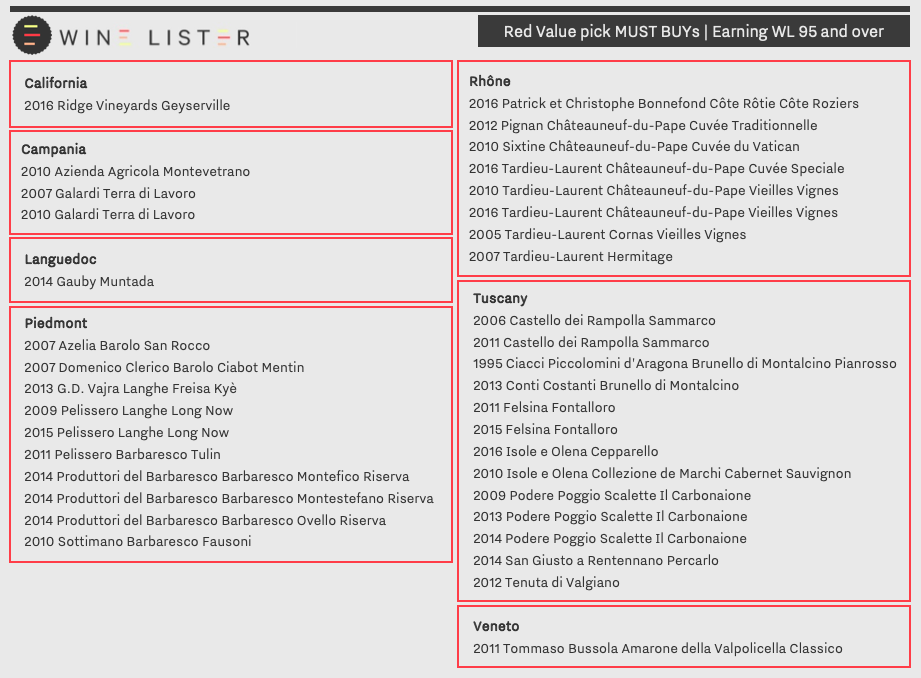
Of the 37 red Value Pick MUST BUYs earning WL 95 and over, a substantial 27 wines hail from Italy, suggesting the impressive quality-to-price ratios offered by many of the country’s producers.
A passion for Piedmont
Famed Piedmont cooperative, Produttori del Barbaresco appears three times on the list, with the 2014 vintages of its Montefico Riserva, Montestafano Riserva, and Ovello Riserva. Despite hailstorms damaging several Barbaresco vineyards in 2014, Produttori’s premium sites are subject to rigorous grape selection, meaning its single-vineyard wines retained quality in the vintage. Achieving the highest score of the three labels from Wine Lister partner critic, Antonio Galloni (96) who calls it a “potent, structured Barbaresco”, the Montefico Riserva can be purchased from Hatton & Edwards for £42 per bottle (in-bond).
Tenderness for Tuscany
Moving further south, Podere Poggio Scalette’s Il Carbonaione is represented by its 2009, 2013, and 2014 vintages, which all achieve WL scores of 95. With over 10 years of age, the 2009 is described by Wine Lister partner critic, Jancis Robinson, as offering a “very voluptuous, exotic nose”, with notes of “both herbs and spices – and some meatiness […] very exciting and bursting with health”. It can be bought from Atlas Fine Wines for £33 per bottle (in-bond).
A romance with the Rhône
Family-owned, micro-négociant, Tardieu-Laurent represents five of the eight Rhône Value picks, with its 2016 Châteauneuf-du-Pape Cuvée Speciale, 2010 Châteauneuf-du-Pape Vieilles Vignes, 2016 Châteauneuf-du-Pape Vieilles Vignes, 2005 Cornas Vieilles Vignes, and 2007 Hermitage. Despite its small-scale production (a consequence of its meticulous selection process), Tardieu-Laurent offers excellent value across its labels. Jancis Robinson awards 18 points to the 2016 Châteauneuf-du-Pape Vieilles Vignes, noting it is “very aromatic and then so sweet and round on the palate! You want to gobble it up immediately”. It can be purchased by the case of 12 from Tardieu-Laurent’s exclusive UK agent, Corney & Barrow for £390 (in-bond).
Caring for California
Representing the New World, Ridge Vineyards’ Geyserville appears in the line-up with its 2016 vintage. A single-site blend of 73% Zinfandel, 17% Carignan, 7% Petite Syrah, and 3% Alicante Bouschet, it achieves a WL score of 95, and is described by Antonio Galloni as offering “black cherry, graphite, lavender, and spice”, with “a purity […] that is absolutely striking”. Also noted by Jancis Robinson as having “snug, focused aromatics with hints of floral lift” and “a palate bursting with flavour”, the 2016 Geyserville can be acquired by the bottle from Lay & Wheeler for £33 (in-bond).
Wine Lister recently teamed up with 67 Pall Mall for a vertical tasting of five d’Issan vintages led by owner, Emmanuel Cruse, and Commercial Director, Augustin Lacaille. Last Wednesday, Emmanuel transported over 60 members of the UK fine wine trade and press to the historic Margaux property, guiding them through four of his favourite recent vintages: 2000, 2005, 2010, and 2015.
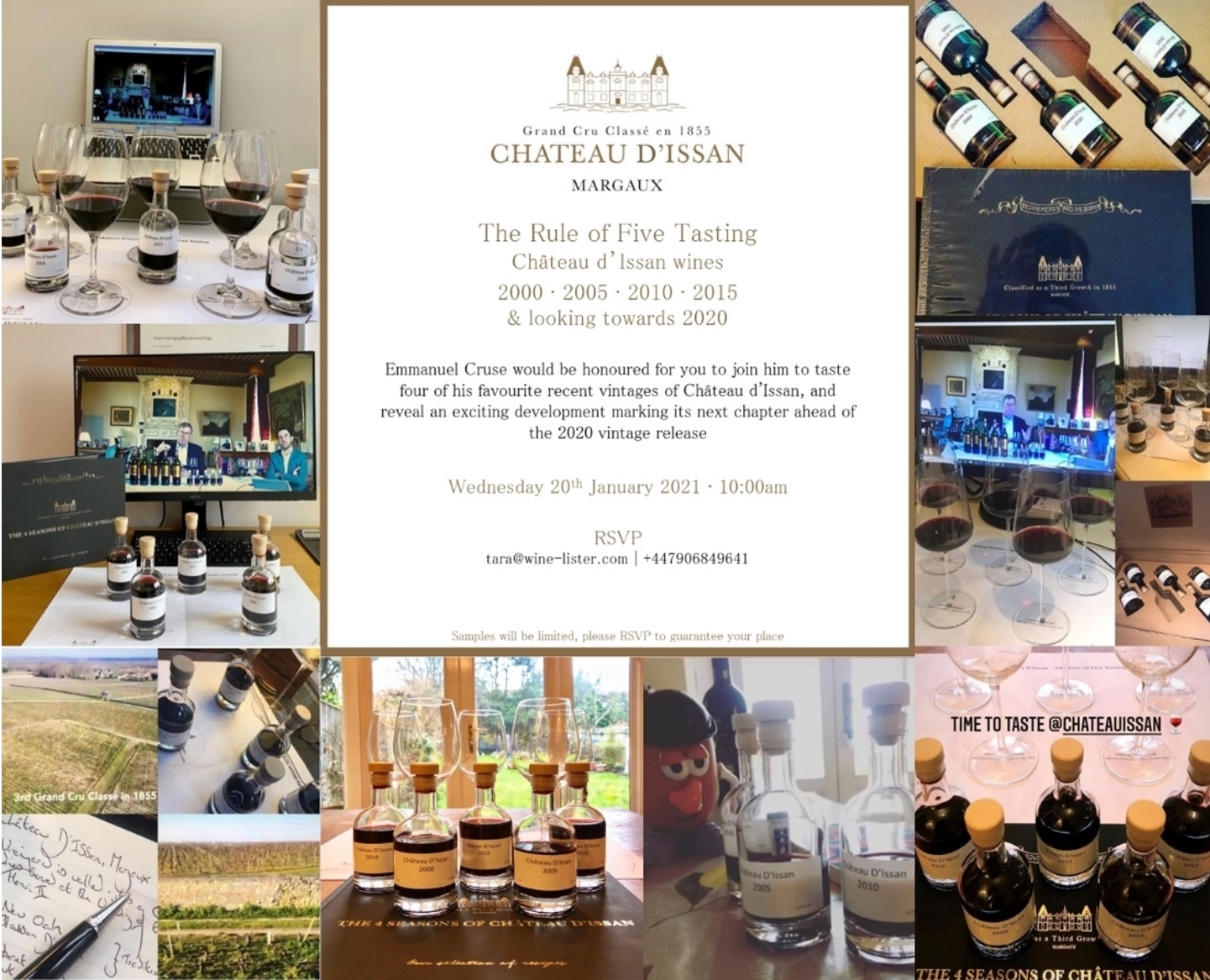 By invitation only: a selection of snaps from guests’ home tasting set-ups. Photos from (from top left anticlockwise): Bud Cuchet (@budcuchet), Charlie Goblet (@charliegoblet), Will Lyons (@mrwill_lyons), Wine Lister (@winelister), Emily O’Hare (@emilyowine), Wine Lister (@winelister), Charlie Goblet (@charliegolet), and Tom Harrow (@winechapuk)
By invitation only: a selection of snaps from guests’ home tasting set-ups. Photos from (from top left anticlockwise): Bud Cuchet (@budcuchet), Charlie Goblet (@charliegoblet), Will Lyons (@mrwill_lyons), Wine Lister (@winelister), Emily O’Hare (@emilyowine), Wine Lister (@winelister), Charlie Goblet (@charliegolet), and Tom Harrow (@winechapuk)
Tasting kits were accompanied by individual copies of The Four Seasons of Château d’Issan – a cookbook assembled by the property’s head chef, Frédéric Braud, with seasonal recipes from a year in the kitchen at d’Issan. Following a short introduction video including aerial scenes of the château and close-ups on its vines, Emmanuel commenced the vertical tasting with the 2000 vintage.
Having taken over as managing director in 1998, he proclaimed that the 2000 was the last “old school” d’Issan. Indeed, the property’s winery has since been almost entirely rebuilt, with a new cellar inaugurated in 2002. The vintage marks the last to be composed of 70% Cabernet Sauvignon and 30% Merlot, the Cabernet proportion being decreased to 60% in 2005.
Emmanuel was not shy in praising the 2005 d’Issan, calling it “the first great vintage” under his watch. He notes there was “perfect weather all year”, recounting how the summer was so warm that the pickers all worked in swimsuits, leading to abnormally regular visits from inquisitive négociants.
According to Emmanuel, 2010 is “from a technical perspective, maybe the best ever vintage made in Bordeaux”. The year had an excellent growing season, void of the hailstorms that had blighted d’Issan in 2008 and 2009. He informed us that the year was also personally special to him, marking the year he married his wife, Virginie. While still on the younger side, Emmanuel suggests decanting the 2010 for three hours ahead of its enjoyment.
The tasting concluded with the 2015 vintages of the property’s Grand Vin and its second wine, Blason d’Issan. Emmanuel stated that it was a broadly excellent year for Bordeaux, and specifically Margaux, which received “less rain than other appellations in the Medoc”. The ratios shifted slightly more towards Cabernet Sauvignon in 2015, which makes up 65% of the blend – Emmanuel’s personal preference.
Hailing from the estate’s younger vines, which are around 15-20 years old, Blason comprises 60% Cabernet Sauvignon in 2015. Emmanuel specifies the same winemaking practices are applied to the second wine, which he hopes to be “an introduction to the flagship”.
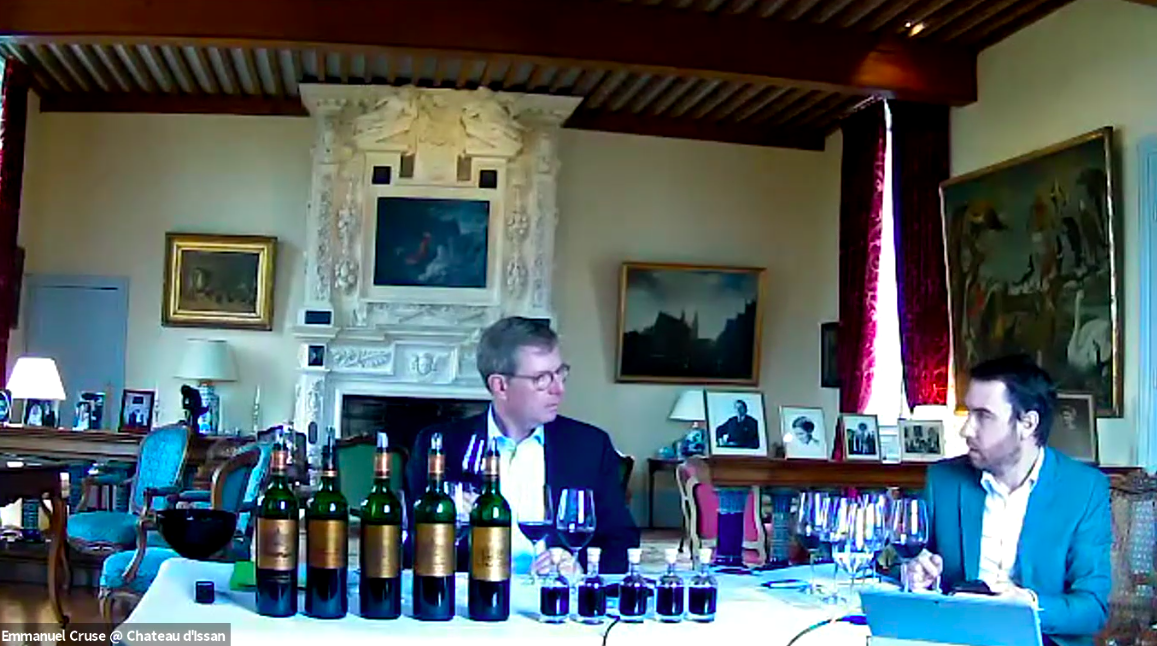 D’Issan owner, Emmanuel Cruse, and Commercial Director, Augustin Lacaille, in “The Rule of Five” virtual tasting
D’Issan owner, Emmanuel Cruse, and Commercial Director, Augustin Lacaille, in “The Rule of Five” virtual tasting
D’Issan 2020 will be released en primeur this year, and we look forward to finding out what the latest edition of “The Rule of Five” will bring – especially since the property’s acquisition of neighbouring Cabernet Franc and Petit Verdot vineyards in March 2020. While the official blend for the 2020 vintage has not been finalised, Emmanuel is sure that the added varietals will be a “real plus”. If the serendipitous pattern of five is anything to go by, especially with the excellent growing season in 2020, the “rule” has every chance of continuing to reign.
For more information on our organisation of virtual tastings and events, please contact the WL PR team here.
It is the ultimate question for Burgundy fans seeking wines for drinking – with prices of the region’s best having risen so high, where can one find value?
Wine Lister’s second Burgundy study published in collaboration with regional specialist, Jasper Morris, notes the proliferation of good value wines hailing from some of the lesser-known appellations, and even outside of the Côte d’Or (Saint-Aubin, Marsannay, Mercurey, and Pouilly-Fuissé were among those mentioned).
Below Wine Lister explores some of the wines worth snapping up from the 2019 campaign*, based on their relative value when compared with other wines in their sought-after appellations. 37 out of the 58 wines listed in charts below are white.

Chablis – a permanent alternative source for Burgundy drinking white outside of the Côte de Beaune – features heavily. Buzz brands William Fèvre and Billaud-Simon achieve multiple entries, as does the Chablis estate of Maison Albert Bichot – Long-Depaquit, and relative newcomer to the cream of the crop, Jean-Paul et Benoît Droin. This group of top Chablis achieves an average price of £52 in bond per bottle, while their Côte de Beaune counterparts cost more than 30% more for the same quality (since both groups achieve an average WL score of 93).
Among the Côte de Beaune whites, Alain Chavy’s Puligny-Montrachet Folatières, and Fontainte-Gagnard’s Chassagne-Montrachet Caillerets provide the best quality-to-price ratios, both achieving WL scores of 94, for £48 and £53 per bottle in-bond respectively. Domaine Rapet’s Corton-Charlemagne provides excellent value for Grand Cru white (considering that the appellation’s reference – Jean-François Coche-Dury – typically costs over £3,000 per bottle).

Only one Grand Cru red makes the cut in top-scorers under £100 per bottle – Georges Lignier’s Clos Saint-Denis.
In the rest of the Côte de Nuits, strong value propositions hail from Taupenot-Merme throughout, particularly its Morey-Saint-Denis La Riotte. Maison Louis Jadot and Heresztyn-Mazzini achieve multiple entries in Gevrey, and the Nuits-Saint-Georges appellation makes an appearance across three producers – Grivot, Faiveley, and Henri Gouges.
The average price difference between the reds of both Côtes is not so dramatic as for Chablis and its Beaune counterparts. Côte de Beaune reds as shown the image above reach an average price of £72, just 10% lower than the Côte de Nuits group (for the same average WL score of 92). Domaine de Montille takes three of the eight places for its Corton Clos du Roi, Volnay Taillepieds, and Pommard Pézerolles.
*N.B. prices are based on those aggregated through Wine Lister’s pricing partner, Wine Owners. Not all Burgundy 2019s have recorded prices as yet, so the above lists may well evolve over the coming weeks and months.
The last lot of Burgundy 2019 scores are in, from Wine Lister’s regional specialist critic, Jasper Morris (Inside Burgundy).
Below we explore Jasper’s top scores by Burgundy “subset”, as defined in Wine Lister’s recent study on the region (recap its key findings here).
While no wines earned perfect scores this year, Jasper’s highest score was in fact awarded to a Premier Cru performing beyond its classification – Arnoux-Lachaux’s Vosne-Romanée Aux Reignots. He notes that the wine is “completely heartbreakingly suave and sensational”, offering “crisply ripe cherries, alpine strawberry, the lightest raspberry touch, then a generous pure clear long finish”.
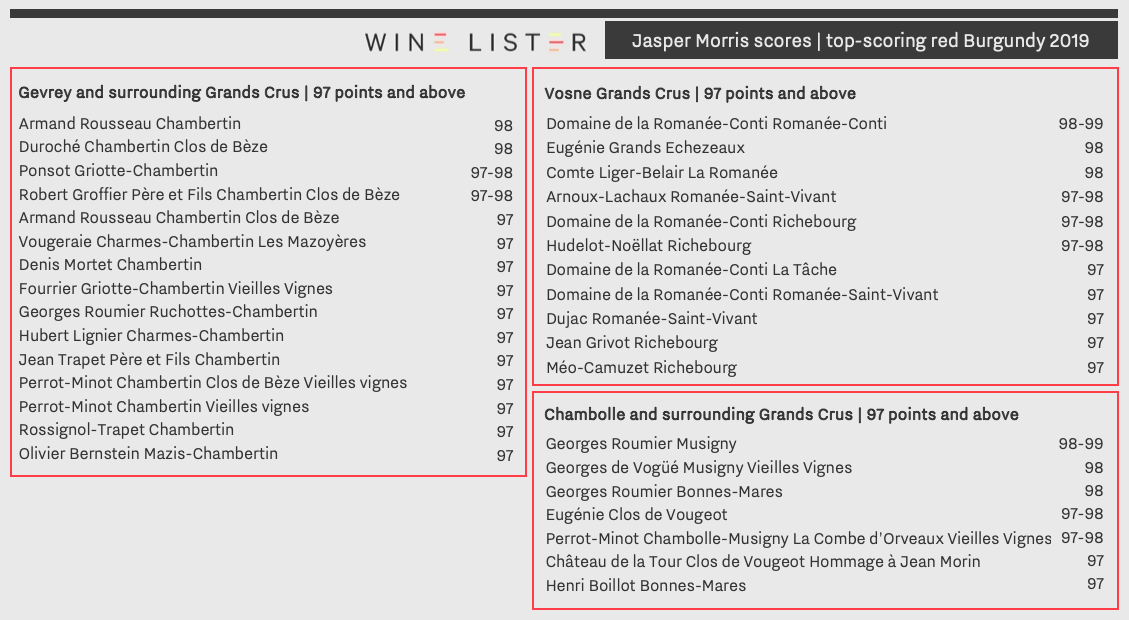
In Gevrey and its surrounding Grands Crus areas, Armand Rousseau fares well, its Chambertin and Chambertin Clos de Bèze earning scores of 98 and 97 respectively. Up-and-comer Domaine Duroché ties for first place within the subset with its Chambertin Clos de Bèze. Jasper describes it as having “a little lick of oak, which is entirely in place, a light, but fresh acidity, a sense of harmony throughout and a deepening of the fruit on the second half of the palate”, creating a “glorious conclusion”.
Georges Roumier proves king of Chambolle and its surrounding Grands Crus, earning two places among the top scorers for the domaine’s Musigny and Bonnes-Mares. Adding testament to the improving quality of maisons de négoce (as mentioned in Wine Lister’s Burgundy study), Maison Henri Boillot makes an appearance among the top ranks for its own Bonnes-Mares.
Domaine de la Romanée-Conti understandably dominates the Vosne Grands Crus category, though star producer Arnoux-Lachaux features among the top 11, in addition to its high-scoring Vosne-Romanée Premiers Crus. Speaking to Wine Lister following the completion of his Burgundy 2019 reports, Jasper notes that Arnoux-Lachaux has “unequivocally joined the greats with a faultless array of stunning wines in 2019, hitting heights of ethereal elegance without sacrificing power”.
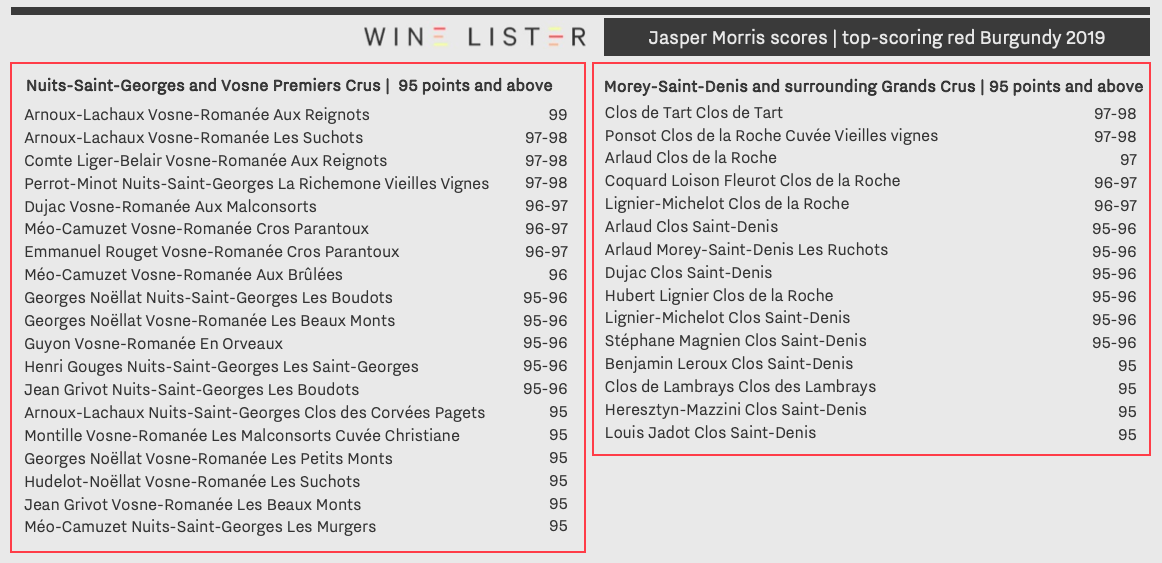
Jasper reports that Morey-Saint-Denis has done well in 2019, as “the village which had the benefit of the best rainfall figures in August”. He adds, “not only are Clos des Lambrays and Clos de Tart progressing well under their new ownerships and winemakers, but class acts such as Domaine Dujac and Christophe Perrot-Minot have filled their boots, while Domaine Arlaud have produced their best set of wines ever”.
Interestingly, no Côte de Beaune red scores above 96 from Jasper in 2019 (though the top scorer at 95-96 points is Méo-Camuzet’s Corton Rognet). See all top scores for Côte de Beaune reds in 2019 here.
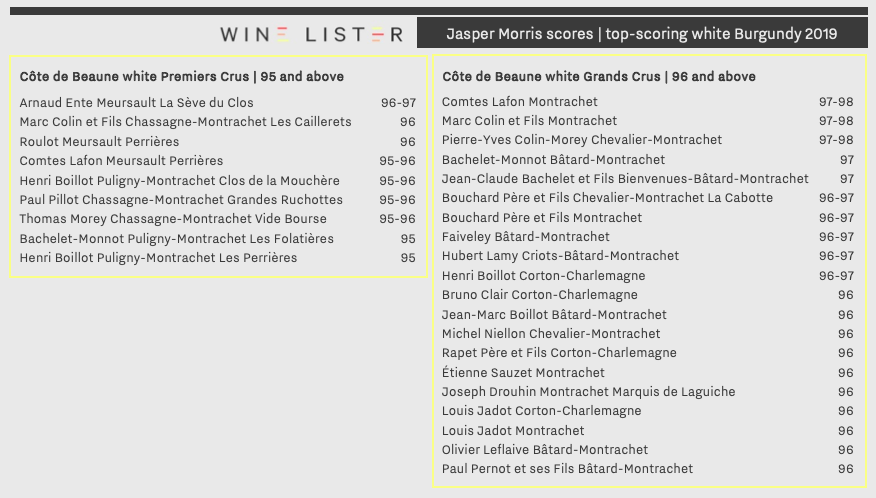
Whites in 2019 do not reach the dizzy score heights of their red counterparts. The above chart therefore takes into account Côte de Beaune white Premiers Crus with scores above 95, and Côte de Beaune Grands Crus achieving 96 points or above.
In the latter subset, maisons de négoce Bouchard Père et Fils and Maison Jadot achieve two entries apiece, for their Chevalier-Montrachet La Cabotte and Montrachet, and Corton-Charlemagne and Montrachet respectively.
Producers Bachelet-Monnot, Comtes Lafon, Domaine Henri Boillot, and Marc Colin also all appear twice in the top Côte de Beaune white rankings for 2019.
View more Burgundy 2019 scores here. Wine Lister Pro users can search and filter by critic scores, and can view all of Jasper Morris’ top Burgundy 2019 scores here. Click here to find out more about the Pro subscription.
The majority of Burgundy 2019 en primeur scores have now been published by another Wine Lister partner critic, Neal Martin (Vinous), offering further insight into the best bottles from the latest vintage.
Explore all Burgundy 2019 WL scores here, or read more below.
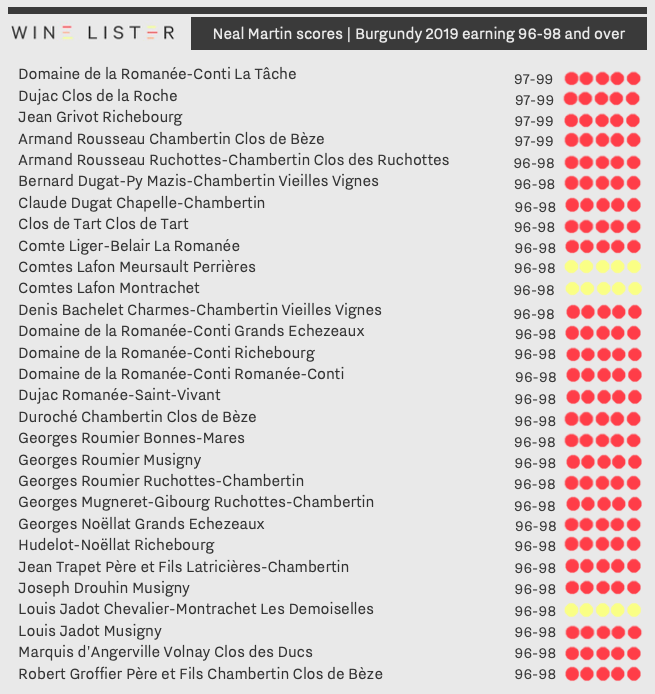
While no wines earned perfect scores this year, fittingly there are 19 Burgundy 2019s that earn 96-98 and above (compared to 15 in 2018). Domaine de la Romanée-Conti La Tâche, Dujac Clos de la Roche, Jean Grivot Richebourg, and Armand Rousseau Chambertin Clos de Bèze fare notably well with scores of 97-99.
Domaine de la Romanée-Conti occupies a further three places on the list, with its Grands Echezeaux, Richebourg, and Romanée-Conti, compared to two Domaine de la Romanée-Conti wines that appear in this score bracket in 2018.
Also scored generously by Jancis Robinson this year (recap our recent examination of her Burgundy 2019 here), Georges Roumier is awarded 96-98 for his Bonnes-Mares, Musigny, and Ruchottes-Chambertin. Featuring on both critics’ list of top-rated wines from the vintage, the Musigny is described by Neal Martin as “beautifully defined on the nose”, offering “a mixture of red and black fruit laced with blood orange, it fans out wonderfully toward the finish”.
The only white Burgundy to gain a score of 18.5 from Jancis Robinson so far, Comtes Lafon’s 2019 Montrachet is one of three whites awarded 96-98 by Neal Martin, alongside its Meursault Perrières and Louis Jadot’s Chevalier Montrachet Les Demoiselles. Members of the Wine Lister team sampled the latter at Louis Jadot’s 2019 en primeur tasting in November 2020 (recap here), and were also impressed, detecting notes of honey and brioche to complement its defined acidity.
Also featured on the list of Burgundy 2019s earning 96-96 and over from Neal Martin are: Armand Rousseau Ruchottes-Chambertin Clos des Ruchottes, Bernard Dugat-Py Mazis Chambertin Vieilles Vignes, Claude Dugat Chapelle-Chambertin, Clos de Tart Clos de Tart, Comte Liger-Belair La Romanée, Denis Bachelet Charmes-Chambertin Vieilles Vignes, Dujac Romanée-Saint-Vivant, Duroché Chambertin Clos de Bèze, Georges Mugneret-Gibourg Ruchottes-Chambertin, Georges Noëllat Grands Echezeaux, Hudelot-Noëllat Richebourg, Jean Trapet Père et Fils Latricières-Chambertin, Joseph Drouhin Musigny, Marquis d’Angerville Volnay Clos des Ducs, and Robert Groffier Père et Fils Chambertin Clos de Bèze.
Though Wine Lister are missing what would have been London’s Bourgogne tasting week this week, our partner critic, Jancis Robinson, has now released the majority of her scores for the 2019 vintage, providing a better picture of the top en primeur picks.
Explore all Burgundy 2019 scores here, or read more below.
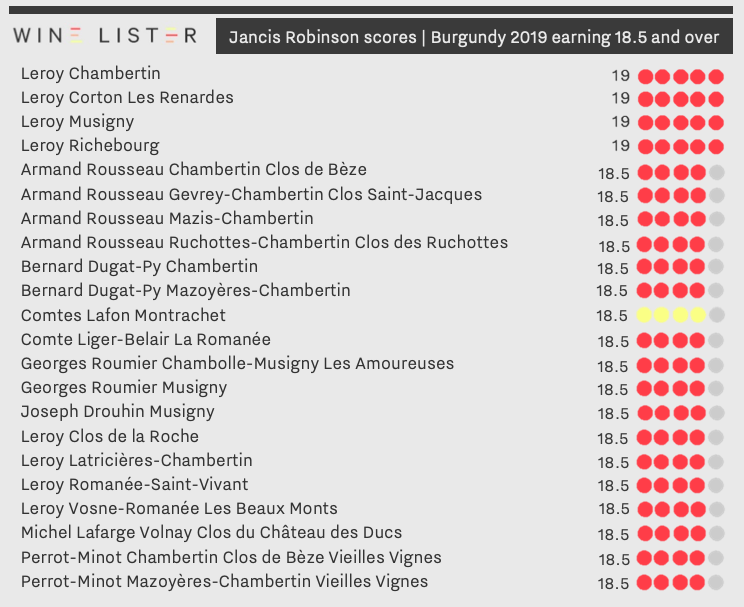
A drought year resulting in wines of extreme concentration, yet balanced by energising acidity (recap Wine Lister’s report on Burgundy’s 2019 vintage here), there are 22 Burgundy 2019s that have so far been given a score of 18.5 or above.
Jancis awarded 19 points to Leroy’s Chambertin, Corton Les Renardes, Musigny, and Richebourg, after having not published any scores for Leroy since the 2013 vintage. The property fares extremely well in 2019, occupying eight places in the list of 22 wines earning 18.5 and over. Leroy’s Clos de la Roche, Latricières-Chambertin, Romanée-Saint-Vivant, and Vosne Romanéee Les Beaux Monts all achieve a score of 18.5.
Armand Rousseau occupies four places in the list, with its Chambertin Clos de Bèze, Gevrey-Chambertin Clos Saint-Jacques, Mazis-Chambertin, and Ruchottes-Chambertin Clos des Ruchottes all earning 18.5 points. While slightly down on her ratings for the property’s 2018 offerings (she awarded 19 points to Rousseau’s Clos de la Roche and Ruchottes-Chambertin Clos des Ruchottes in 2018, and a further 18.5 points to its Chambertin, Chambertin Clos de Bèze, and Gevrey-Chambertin Clos Saint-Jacques), it nonetheless continues its excellent quality performance in 2019.
Comtes Lafon’s 2019 Montrachet is the only white Burgundy to gain a score of 18.5 from Jancis Robinson so far, continuing its series of top scores awarded by the critic in recent years. She describes it as “Both rich and savoury. Not remotely fat but with massive intensity. Throbbing and jewel-like”, concluding that “Dominique [Lafon] must be thrilled by this”.
Also featured on the list of Burgundy 2019s earning 18.5 and over from Wine Lister partner critic, Jancis Robinson are: Bernard Dugat-Py Chambertin, Bernard Dugat-Py Mazoyères-Chambertin, Comte Liger-Belair La Romanée, Georges (or Christophe) Roumier Chambolle-Musigny Les Amoureuses, Georges (or Christophe) Roumier Musigny, Joseph Drouhin Musigny, Michel Lafarge Volnay Clos du Château des Ducs, Perrot-Minot Chambertin Clos de Bèze Vieilles Vignes, and Perrot-Minot Mazoyères-Chambertin Vieilles Vignes.
View more Burgundy 2019 scores (including those of Jasper Morris and Neal Martin) here.
As we stayed hunkered down for much of 2020, Wine Lister was working on a new interactive tool for its website users: the Vintage Chart. Adding further breadth to our rating and information hub, this new feature allows side-by-side comparisons of top vintages from various countries, regions, and appellations.
See the example of Côte de Nuits reds below for some of the best of Burgundy’s back vintages, or explore the Vintage Chart for yourself here.
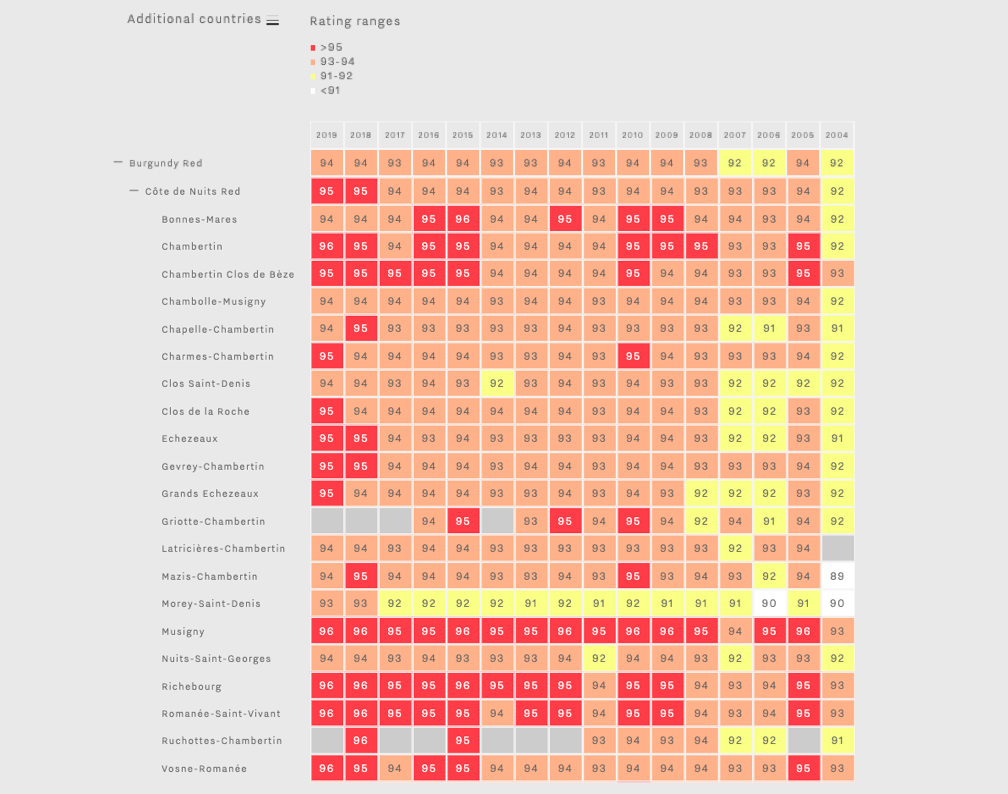
The Vintage Chart above compares the past 16 vintages of Côte de Nuits reds by WL score, based on the average WL scores of the top-performing wines in each “line”.
Informed by the latest available scores from two of Wine Lister’s partner critics, Jancis Robinson, Jasper Morris, and Neal Martin (Vinous) a look at the 2019 column reveals the success of Musigny, Richebourg, Romanée-Saint-Vivant, and Vosne-Romanée in the most recent vintage currently being released en primeur. The top-performing wines across the four appellations achieve an average WL score of 96, followed closely behind by Chambertin, Chambertin Clos de Bèze, Charmes-Chambertin, Clos de la Roche, Echezeaux, Gevrey-Chambertin, and Grands Echezeaux all gaining an average WL score of 95 in 2019.
Using the horizontal scroll to explore back vintages, one can see that Musigny is the most consistently high-scoring Côte de Nuits red appellation, with its top wines achieving an average WL score of 95 and above in the 15 vintages since 2004.
Click here to explore the Vintage Chart for yourself, or watch our video demonstration to find out how to get the most out of this new interactive tool here.
Wine Lister Pro members have access to a more extensive Vintage Chart, which integrates our holistic 360° rating system to visualise the average scores in the Economics and Quality categories, as well as by overall WL Pro score (which also takes into account a wine’s Brand clout). Log in to your account to view the Pro Vintage Chart here, or find out more about the Pro subscription here.
The end of 2020 is perhaps reason enough to pop open a bottle of champagne. With Christmas and New Year around the corner, Wine Lister has compiled a list of 21 Champagne MUST BUYs to enjoy over the last days of this year, and into 2021. Whether you have a penchant for discovering grower champagnes, or prefer to relish in those the top Grandes Maisons have to offer; whether you enjoy the purity of a Blanc de Blancs, the balance of an assemblage, or the opulence of a Blanc de Noirs, the selection of vintage champagnes below is sure to offer guidance for any preferred style.
Find out more about our 21 Champagne MUST BUYs for 2021 below.
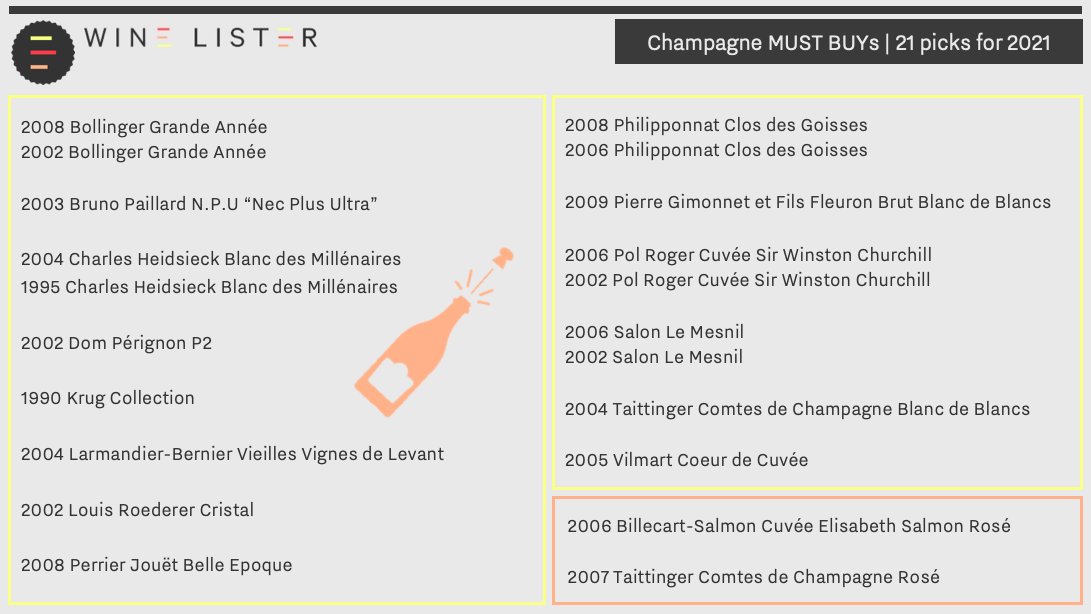
Long-established house, Charles Heidsieck, is represented in our MUST BUY selection with two vintages of its Blanc des Millénaires – 1995 and 2004. The wine is so-named to reflect its high ageing potential, and is only created in vintages worthy of the label (since its inception, just five have been made). The 2004 achieves a WL score of 95, and is praised by Wine Lister partner critic, Jancis Robinson, as having “sheer confidence, appeal and completeness”. Earning one more WL point, the 1995 shows “just how compelling this often-overlooked vintage can be”, according to Wine Lister partner critic, Antonio Galloni (Vinous). Both vintages can be bought by the case of six in-bond from Cru World Wine.
Also the crown jewel of its own house, Perrier-Jouët’s Belle Epoque carries its own portion of history within its name, referencing the Art Nouveau movement of the early 1900s. The prestige bottling can be appreciated on the inside and out, particularly in the spectacular 2008 vintage. Wine Lister tasted it recently, and found it to have a concentrated nose of white peaches, brioche, and a hint of honeysuckle, with brilliant tension on the palate. 2008 Belle Epoque is available to purchase by the bottle from Lay & Wheeler, for £129 (in-bond).
A further two MUST BUYs hail from the boutique house, Philipponnat Clos des Goisses. The 5.5-hectare Clos de Goisses parcel is the oldest and steepest “Clos” in champagne. The 2006 and 2008 vintages of this single-vineyard cuvée both receive a WL score of 96. Jancis Robinson praises both vintages, writing that the 2006 “positively screams for attention”, while the 2008 is “explosive… like a firework on the palate”. They can both be acquired in-bond from Bordeaux Index.
Included in our 21 MUST BUY champagnes are two grower offerings lying outside of champagne’s more widely-declared vintages. Notorious for its killer heatwave, 2003 is not well-appreciated among the champenois. Bruno Paillard’s 2003 N.P.U. challenges this perception, offering a “dancing” palette of “open and floral notes” according to Jancis Robinson. Acknowledging that the vintage was hugely criticised, Paillard says that for him, “it’s a great vintage”. Another elusive grower champagne rounds off our list. Jancis Robinson hailed the 2005 Vilmart Coeur de Cuvée as “a wine to wallow in”, praising its complexity and “refreshing finish”.
Also featured in the list of 21 Champagne MUST BUYs for 2021 are: 2006 Billecart-Salmon Cuvée Elisabeth Salmon Rosé, 2008 Bollinger Grande Année, 2002 Bollinger Grande Année, 2002 Dom Pérignon P2, 1990 Krug Collection, 2004 Larmandier-Bernier Vieilles Vignes de Levant, 2000 Louis Roederer Cristal, 2009 Pierre Gimonnet et Fils Fleuron Brut Blanc de Blancs, 2006 Pol Roger Cuvée Sir Winston Churchill, 2002 Pol Roger Cuvée Sir Winston Churchill, 2006 Salon Le Mesnil, 2002 Salon Le Mesnil, 2004 Taittinger Comtes de Champagne Blanc de Blancs, and 2007 Taittinger Comtes de Champagne Rosé
As 2020 draws to a close, Wine Lister has compiled a report celebrating the top-performing wines and producers within a series of categories over the past year. Using our axes of Quality, Brand, and Economics, and the several factors that constitute these values, we have created seven leagues that paint a panoramic view of some of the world’s best wines, ranked within their areas of excellence.
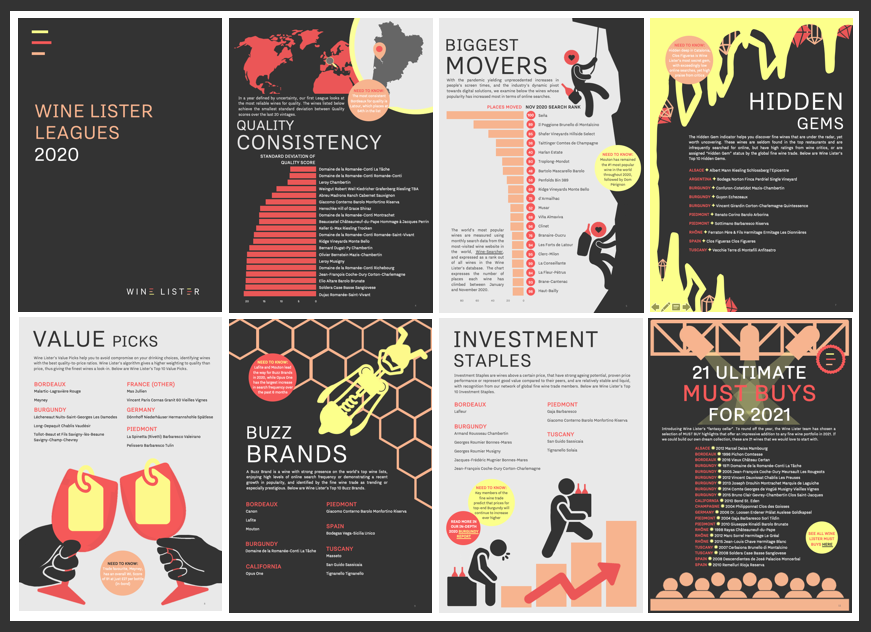
Wine Lister’s 2020 Leagues include rankings of Quality Consistency (wines that show the smallest standard deviation between Quality scores over the last 20 vintages), and Biggest Movers (wines whose popularity has increased most in terms of online searches over the past year). Our team has also put together its top-10 wines per Wine Lister Indicator, revealing our recommendations for Hidden Gems, Value Picks, Buzz Brands, and Investment Staples.
We end the Leagues with a list of 21 Ultimate MUST BUYs for 2021, compiling a selection of MUST BUY highlights hand-picked by our fine wine experts, that offer an impressive addition to any fine wine portfolio in 2021. These are some of the picks that would feature in Wine Lister’s “fantasy cellar”.
Download your free copy of Wine Lister’s 2020 Leagues here.
If ever there is a time for claret, it’s Christmas. While Bordeaux generally provides excellent quality for its prices relative to other regions all year round, it is an especially good source for festive bottles with a bit of age. Below Wine Lister offers one MUST BUY under £100 per Bordeaux appellation – a selection that promises to please with your Christmas meal.
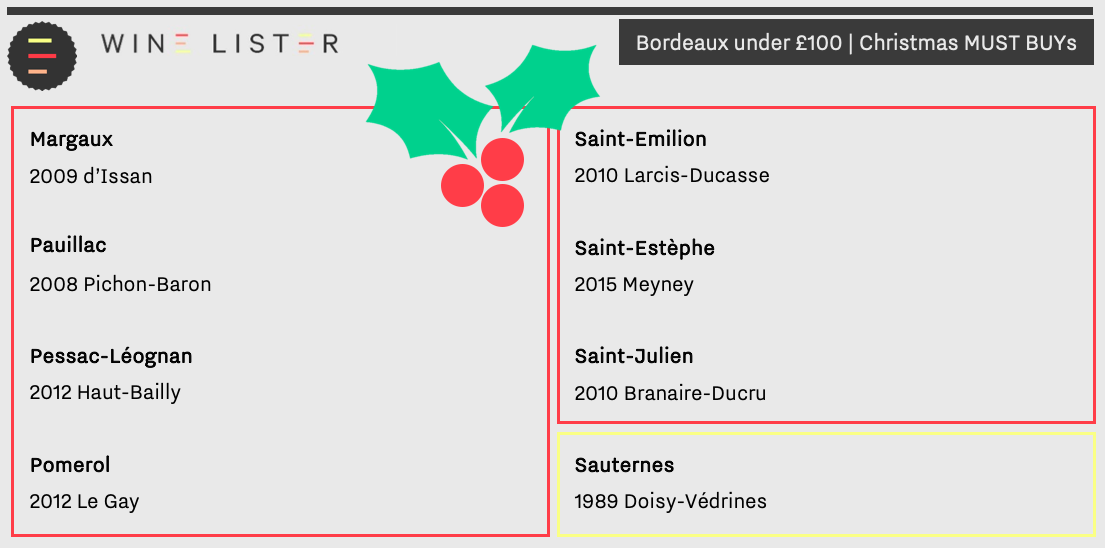
Aside from its lustrous gold label providing an appropriate centrepiece to any festive feast, d’Issan 2009 offers good value for its appellation, earning a WL score of 93 at £56 per bottle (in-bond). Château owner, Emmanuel Cruse, is also the “Grand Maître” of the Commanderie du Bontemps – a Bordeaux organisation uniting trade members in the preservation of Bordeaux’s excellent quality reputation. D’Issan embodies the values of its maker, exemplifying the traditional claret style with added Margaux elegance. It is available to purchase by the case of 12 from Nickolls and Perks.
Pauillac powerhouse Pichon-Baron 2008 is described by Wine Lister partner critic, Neal Martin (Vinous), as one of the property’s “overachievers in recent years”. Often noted for being one of the most concentrated wines of the vintage in its appellation and beyond, Martin writes that the 2008 is “full of tension and energy […] delivering real brightness and vivacity on the finish”. At £90 per bottle (in-bond), it is the most expensive wine featured in this article, however, its Second Growth status and an abundance of critics’ praise make it worthy of consideration. Pichon-Baron 2008 can be acquired by the case from Lay & Wheeler.
A top-quality substitute to some of Haut-Bailly’s more costly back vintages, the 2012 achieves the property’s second-best WL score ever, as well as second place for quality among Pessac-Léognan reds for the vintage. Wine Lister partner critic, Antonio Galloni (Vinous), states that “the decision to lower temperatures in fermentation and go for a soft, gentle extraction, along with strict selection has paid off big time” in 2012, revealing notes of “dark raspberries, mint, crushed flowers, spices and rose petals”. Haut-Bailly 2012 is just entering its drinking window, and can be bought from Cru Wine.
Finding value on Bordeaux’s right bank can be trickier, particularly in Pomerol. Le Gay 2012 nonetheless offers excellent quality (WL 94) for the relatively reasonable price of £61 per bottle (in-bond). Wine Lister partner critic, Jancis Robinson, notes that it reaps “real Pomerol reward in terms of concentration”, offering a “very well-integrated nose […] sweet and focused”. In neighbouring Saint-Emilion, Larcis-Ducasse 2010 is described as “simply stunning” by Antonio Galloni, who notes “violet, lavender, graphite and menthol” that “give the 2010 its energy and tension”. It gains a WL score of 94, at £87 per bottle (in-bond). Both of these right bank picks can be purchased from Cult Wines.
Achieving Value Pick status, Saint-Estèphe’s Meyney 2015 has a WL score of 93 at £25 per bottle (in-bond), providing a veritable steal for your Christmas meal. After sampling at the annual Southwold Bordeaux tasting, Neal Martin writes that it “was the shock of this blind tasting – in a positive sense […] I thought it might be Montrose but it turned out to be Meyney. Chapeau!” Though the 2015 could benefit from a few more years of ageing, it is a brilliant gift option for your more patient guests, and can be acquired from Goedhuis & Co.
Saint-Julien star, Branaire-Ducru’s 2010 vintage was described as “dancing” by Jancis Robinson. Neal Martin’s tasting note suggests a wine of complexity: “a lovely mélange of red and black fruit, hints of dried blood and autumn leaves suggesting that this is moving into its secondary phase”. With a WL score of 93, Branaire-Ducru 2010 can be purchased by the case of 12 from Farr Vintners for £52.50 per bottle (in-bond).
For a sweet end to your Christmas meal, Wine Lister suggests Doisy-Védrines 1989. With 30 years of ageing under its belt, it achieves a WL score of 94 – the château’s highest ever. It is described by Neal Martin as boasting “a captivating bouquet of gorgeous wild honey, Seville orange marmalade, fig jam and light lemongrass scents”. He adds, “it is simply everything you desire in a sweet Bordeaux”. Purchase Doisy-Védrines 1989 by the bottle from Hedonism Wines for £62.80 (in-bond).













